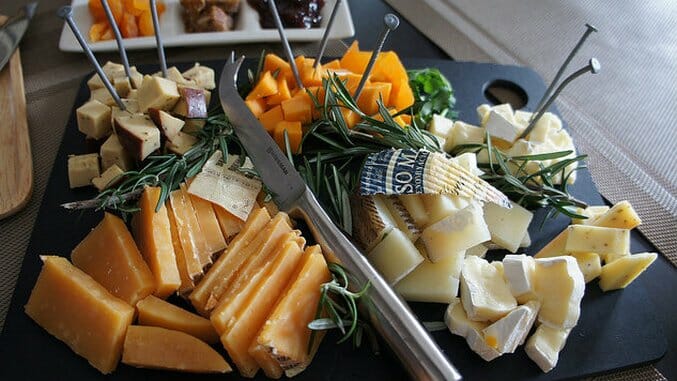The Gorgonzola is Greener on the Other Side of the Table
An Indian-Canadian food writer reminisces on her childhood discovery of stinky cheese
Food Features
I was a cheese innocent ‘til I turned nine.
I’d read about it in stories like Heidi and I ate paneer, India’s sole contribution to cheese making.
But the closest thing to Western fromage I’d tasted was processed, tinned cheese, the only kind you could get in India till the late 1980s. It mimicked an English industrial product from the World War era – thick, yellow, tangy, hardly subtle.
With nothing to compare it to, we liked it well enough. It was the filling in tomato-cheese sandwiches and my Lieutenant Colonel grandfather munched it with his chota peg (small shot of rum) every evening.
But my life changed forever when my family moved to Canada in 1977. There, thanks to a round of Edam, I fell into endless love with the real thing.
At school in London, Ontario, I made friends with Anouk, whose hair reminded me of Pippi Longstocking’s. Her parents, Rudolf and Thera Bikkers, had migrated from Holland. Anouk’s father was an artist and lithographer; her mom assisted her husband with his work.
One day, my friend invited me to eat my lunch at her house. When I walked in, I was enchanted by rooms that belonged in a Dutch painting. On the walls were Rudolph’s colorful abstracts. The sounds of classical cello music washed over us. The delicate autumn light and spare northern European aesthetic in the dining room reminded me of the softness in Johannes Vermeer’s “The Girl with the Wine Glass.” I caught my breath and my romantic young soul quivered.
At the far end, under two windows, was a harvest table flanked by wooden benches. On it was exhibited a culinary still life. I stared, captivated. There were sliced breads – pumpernickel, rye, other golden or dark, grainy loaves. Ripe red tomatoes, crisp apples and gleaming pears beckoned. A dish of rich brown Schokoladenstreusel (chocolate sprinkles) tempted me.
And there were the cheeses, whose names I was yet to discover. Meltingly soft Brie, delicately veined Roquefort, Swiss, strewn with holes. What was that ball with the red waxy skin?
This was what lunch should look like, I thought. With eyes as big as saucers, I shyly unpacked my Kraft cheese sandwiches. Having only been in London a month, my parents were grocery store novices. Used to shopping at bazaars in India where you selected your own fruits and vegetables after looking, sniffing and pressing, Western supermarkets were a mystery. Mom couldn’t judge the readiness of tomatoes wrapped in cellophane or the quality of frozen chicken. She bought standard white bread from Loblaw’s and Kraft processed cheese because the brand was familiar.
Anouk and her brother looked at my food, then at each other, a glint in their eyes. Thera set a plate in front of me, saying hospitably, “Bunny, please help yourself.” I was thrilled. So was Anouk.
She jumped up and asked excitedly, much to her mother’s chagrin, “Could we have your sandwiches then?”
Obviously, she and Tibor didn’t get white bread or processed cheese often. I stretched across the table, gladly handing off my packet to them. While they reveled in the spongy bread and unnaturally orange slices, I feasted on their lunch.
Thera sliced into the red ball – Edam – and I put it on rye. I took little nibbles to make the gentle nuttiness last. I didn’t know it was named after a Dutch city or that it appeared in the name of a 1911 film, “How Edam Cheese is Made.” I only knew it was saying a sweet hello to my palate. I responded by falling in love.
I reached for the pungent Brie, spreading it on my bread and blinking at its full tartness. I don’t understand you yet, I thought. Finally, I tried the easy Swiss whose holes intrigued me. I “ate” them, imagining I was devouring air.
Cheese became a huge part of our lives. Mom learned the Canadian tradition of serving it with hot apple pie; it was Dad’s favorite snack. As my cheese-loving Canadian boyfriend says, “Apple pie without the cheese is like a hug without the squeeze.”
Anouk’s vegan now. I’ve become fickle, having love affairs with Camembert, Gruyère, Comté, Époisses, Bucheron – cheeses for different ages. But when I see a round of Edam, I have to take a bite. Its flavor transports me back to London and that magical day of discovery.
Main photo by Andrea Goh CC BY and Skånska Matupplevelser CC BY
Kaumudi Marathe is a writer turned chef. In 2007, she opened a catering company and cooking school in Los Angeles to shatter the myth that all Indian food is curry. Her food memoir, “We are the Hero,” is out this September. You can follow her on Instagram or on Twitter.